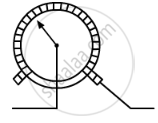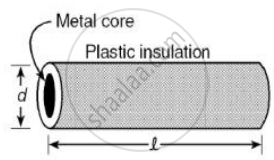Advertisements
Advertisements
Question
How will the resistance of a wire be affected if its
- length is doubled, and
- radius is also doubled ?
Give justification for your answer.
Solution
R `=(rho"l")/"A"`
Where, `rho` = electrical resistivity
l = length of the conductor
A = cross-sectional area of the conductor
Hence if the length is double then
⇒ `"R"_1=rho((2"l"))/"A"`
`therefore "R"_1 = 2("R")`
So, if the length of the resistance gets doubled then resistance also gets doubled.
Now when the radius is double then
⇒ `"R"_2 = (rho"l")/"A"`
⇒`"R"_2 = (rhol)/(pi(2"r")^2`
`therefore "R"_2 = 1/4("R")`
So if the radius gets doubled then resistance will be `(1/4)^"th"` of initial resistance.
APPEARS IN
RELATED QUESTIONS
Use the data in the Table given below to answer the following –
Which among iron and mercury is a better conductor?
Table give below Electrical resistivity of some substances at 20°C
| Electrical resistivity of some substances at 20°C | ||
| − | Material | Resistivity (Ω m) |
| Conductors |
Silver | 1.60 × 10−8 |
| Copper | 1.62 × 10−8 | |
| Aluminium | 2.63 × 10−8 | |
| Tungsten | 5.20 × 10−8 | |
| Nickel | 6.84 × 10−8 | |
| Iron | 10.0 × 10−8 | |
| Chromium | 12.9 × 10−8 | |
| Mercury | 94.0 × 10−8 | |
| Manganese | 1.84 × 10−6 | |
| Alloys |
Constantan (alloy of Cu and Ni) |
49 × 10−6 |
| Manganin (alloy of Cu, Mn and Ni) |
44 × 10−6 | |
| Nichrome (alloy of Ni, Cr, Mn and Fe) |
100 × 10−6 | |
| Insulators | Glass | 1010 − 1014 |
| Hard rubber | 1013 − 1016 | |
| Ebonite | 1015 − 1017 | |
| Diamond | 1012 − 1013 | |
| Paper (dry) | 1012 | |
What is meant by conductors and insulators? Give two examples of conductors and two of insulators.
Which of the following are conductors and which are insulators?
Sulphur, Silver, Copper, Cotton, Aluminium, Air, Nichrome, Graphite, Paper, porcelain, Mercury, Mica, Bakelite, Polythene, Manganin.
What happens to the resistance as the conductor is made thicker?
Which among iron and mercury is a better conductor of electricity?
What will be the resistance of a metal wire of length 2 metres and area of cross-section 1.55 × 10−6 m2 if the resistivity of the metal be 2.8 × 10−8 Ω m?
What would be the effect on the resistance of a metal wire of:
increasing its temperature?
The figure blow shows a variable resistor in a dimmer switch.

How would you turn the switch to make the lights: (a) brighter, and (b) dimmer? Explain your answer.
How will you infer with the help of an experiment that the same current flows through every part of the circuit containing three resistors R1, R2 and R3 in series connected to a battery of V volts?

Plastic insulation surrounds a wire having diameter d and length l as shown above. A decrease in the resistance of the wire would be produced by an increase in the ______.
